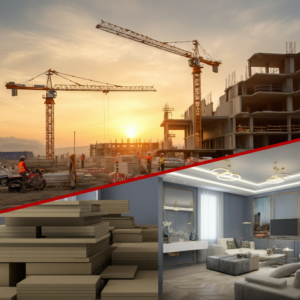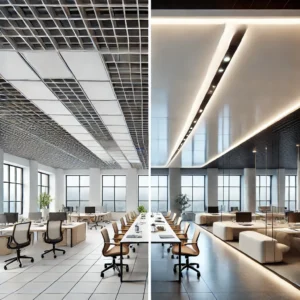At Space Ceiling, we often get asked about the ideal height for residential ceilings. The standard ceiling height in modern homes can significantly impact the overall feel and functionality of a space.
In this post, we’ll explore the average ceiling heights in contemporary houses, factors that influence these standards, and how different ceiling heights affect room aesthetics and energy efficiency. We’ll also discuss alternative options like tray ceilings and stretch ceilings for those looking to break away from the norm.
How High Are Modern Home Ceilings?
The New Standard in Residential Ceiling Heights
Modern homes have witnessed a significant evolution in ceiling heights. The current standard for residential ceiling height typically ranges from 9 to 10 feet, a notable increase from the 8-foot norm of previous decades. This shift reflects a growing preference for more spacious and airy interiors.
Factors Driving the Trend Towards Higher Ceilings
Several factors contribute to this upward trend:
- Improved Construction Techniques: Advanced building methods and materials have made it more feasible to construct homes with higher ceilings without substantially increasing costs.
- HVAC Advancements: Modern heating, ventilation, and air conditioning systems efficiently manage larger spaces, addressing previous concerns about energy efficiency in homes with high ceilings.
- Aesthetic Appeal: Higher ceilings create a sense of openness and grandeur, which many homeowners find desirable.
Regional Variations in Ceiling Heights
Standard ceiling heights can vary depending on geographic location and local architectural styles. Homes in warmer climates often feature higher ceilings to aid in natural ventilation and cooling, while homes in colder regions might opt for slightly lower ceilings to conserve heat.
Building Codes and Minimum Height Requirements
While trends lean towards higher ceilings, building codes set the minimum standards for residential ceiling heights. In the United States, the International Residential Code (IRC) specifies a minimum ceiling height of 7 feet for habitable spaces. However, local building codes may have additional requirements or exceptions.
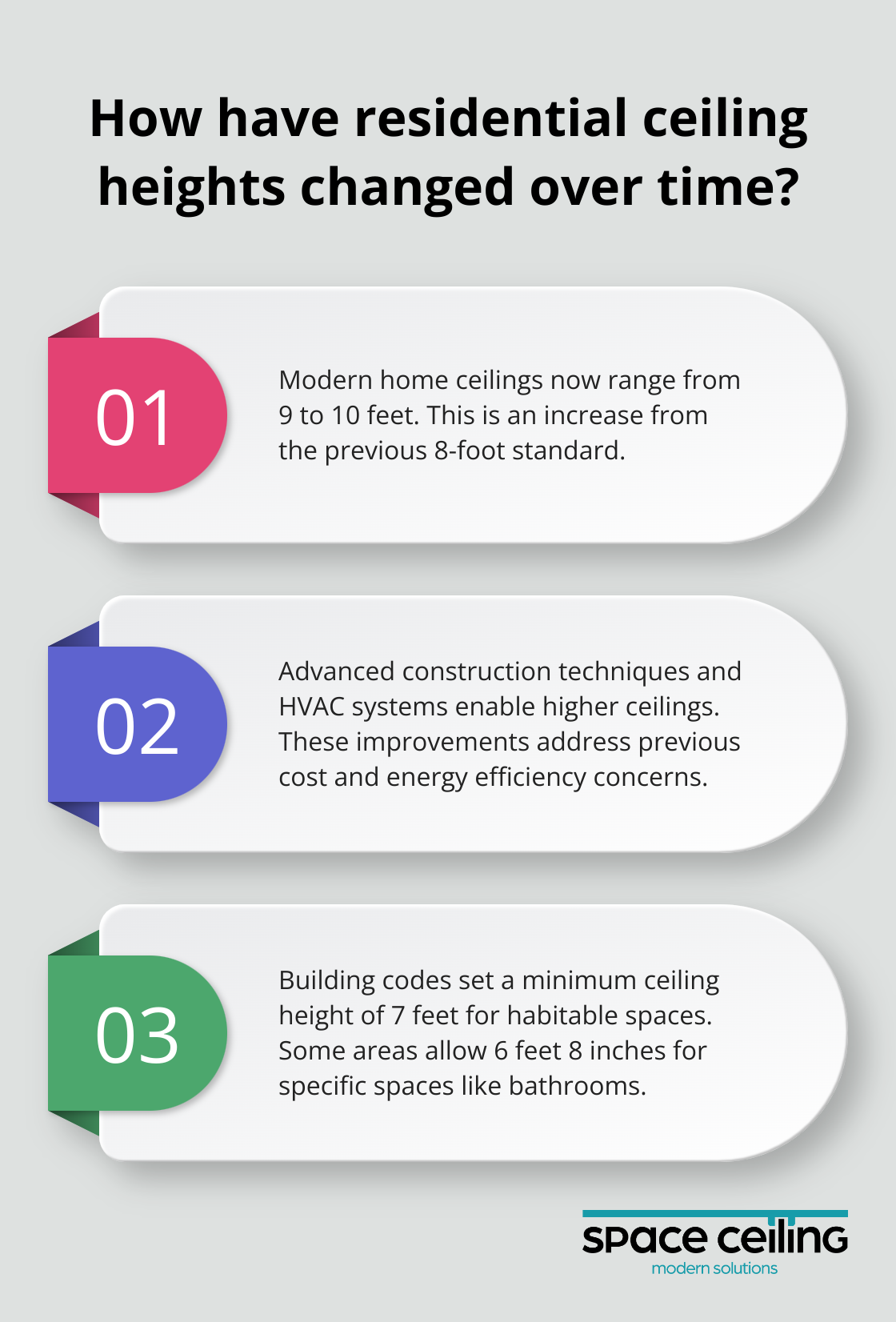
Some jurisdictions allow for lower ceilings in specific areas like bathrooms or beneath beams (typically no less than 6 feet 8 inches). Homeowners and builders should always consult local building codes before finalizing any construction or renovation plans.
The Impact of Ceiling Height on Home Value
Higher ceilings can significantly influence a home’s perceived value. This premium reflects the desirability of spacious, airy interiors among homebuyers.
As we explore the impact of ceiling heights on home design, it becomes clear that this architectural element plays a crucial role in shaping the overall feel and functionality of living spaces. The next section will examine how different ceiling heights affect room aesthetics and perceived spaciousness, providing valuable insights for homeowners considering renovations or new construction projects.
How Ceiling Height Shapes Your Home
The Visual Impact of Ceiling Height
Ceiling height dramatically influences the look and feel of living spaces. Higher ceilings create an immediate sense of grandeur and openness. They allow for larger windows, which flood rooms with natural light, making spaces feel airier and more inviting. In contrast, standard 8-foot ceilings can make rooms feel more intimate and cozy, which is often desirable in bedrooms or smaller living areas.
Perception of Space and Room Size
Ceiling height doesn’t just affect how a room looks-it changes how we perceive its size. A study published in the Journal of Consumer Research found that variations in ceiling height can prime concepts that, in turn, affect how consumers process information. This perception can be particularly beneficial in smaller homes or apartments, where higher ceilings can create an illusion of more space without actually increasing square footage.
Energy Efficiency Considerations
While higher ceilings can create stunning visual effects, they also impact a home’s energy efficiency. Rooms with high ceilings require more energy to heat and cool, as there’s simply more air volume to manage. However, this doesn’t mean high ceilings are inherently inefficient.
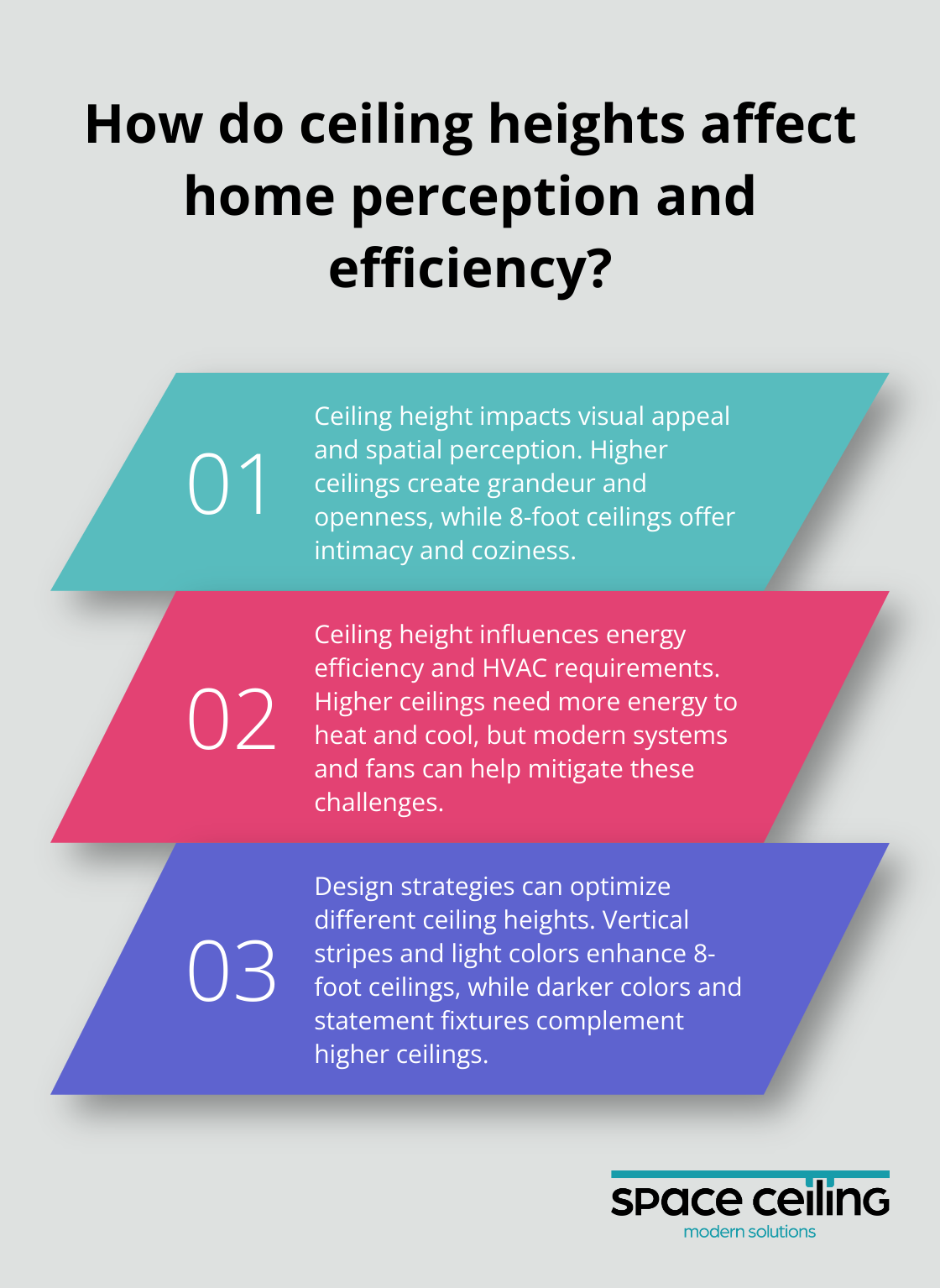
Modern HVAC systems and smart home technologies can help mitigate these challenges. For instance, ceiling fans can help circulate air more effectively in high-ceilinged rooms, reducing the load on air conditioning systems. In colder months, reverse-direction ceiling fans can push warm air down, improving heating efficiency.
Practical Tips for Different Ceiling Heights
For homes with standard 8-foot ceilings, use vertical stripes on walls or floor-to-ceiling curtains to create an illusion of height. Light colors on both walls and ceilings can also make spaces feel more open.
In rooms with high ceilings, consider using darker colors or textured finishes on the ceiling to create a sense of intimacy. Large, statement light fixtures or chandeliers can also help fill vertical space and draw the eye upward, enhancing the room’s grandeur.
Innovative Solutions for Ceiling Design
For those looking to maximize the benefits of high ceilings while minimizing energy costs, stretch ceilings offer an innovative solution. These ceilings can be installed with integrated insulation, helping to maintain comfortable temperatures while preserving the aesthetic appeal of lofty spaces. (Space Ceiling provides top-quality stretch ceilings that combine functionality with stunning design.)
As we explore alternative ceiling designs, it’s clear that the possibilities extend far beyond standard heights. Let’s examine some unique ceiling options that can add character and value to your home.
Beyond Standard Ceilings: Unique Design Options
Tray Ceilings: Elegant Depth and Dimension
Tray ceilings add depth and visual interest to a room without extreme height. These ceilings feature a raised center section that resembles an inverted tray, typically rising 6 to 14 inches above the room’s perimeter. Their versatility allows for customization with various shapes and enhancements like lighting or decorative molding.
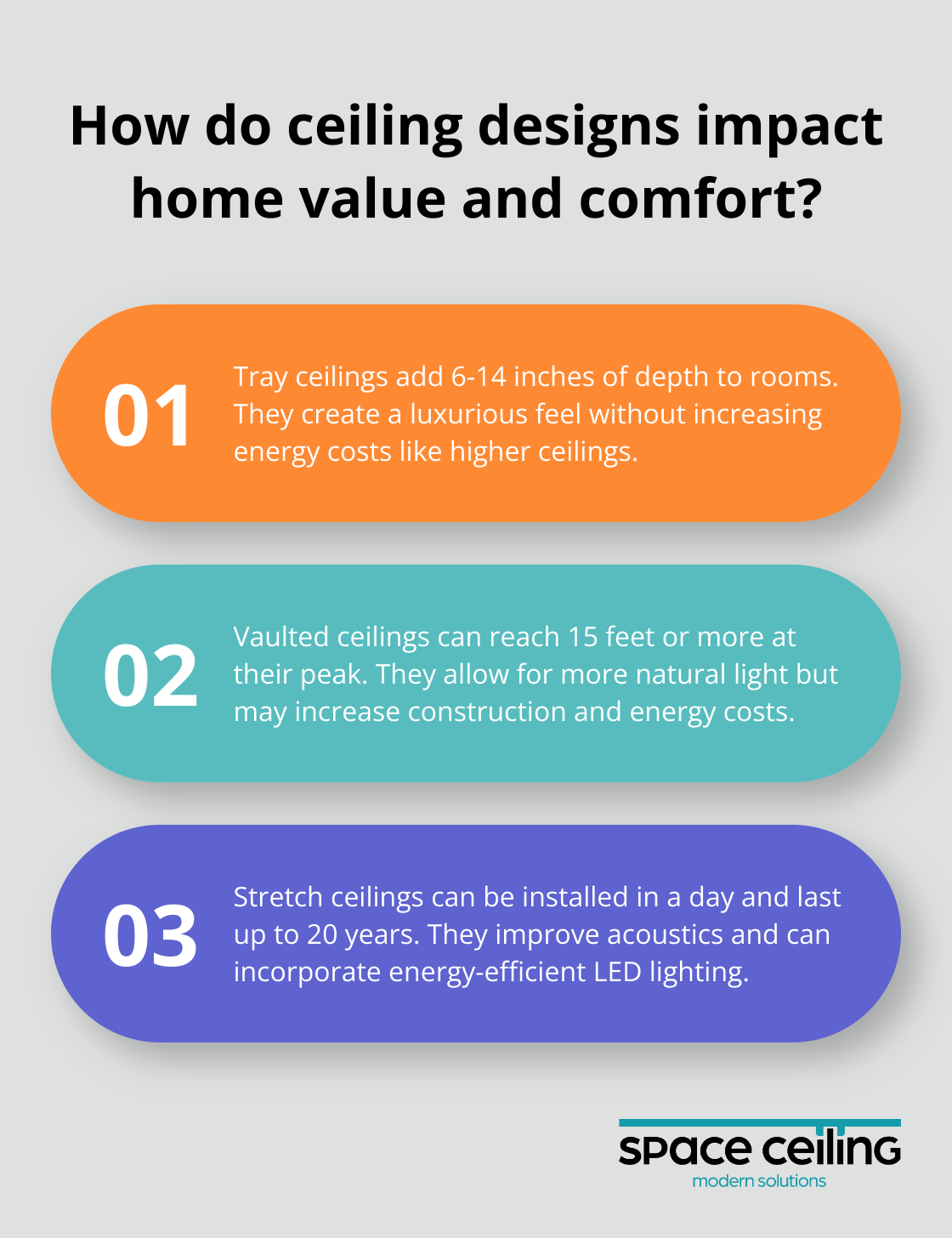
Tray ceilings excel in master bedrooms, dining rooms, and living areas. They create a larger, more luxurious feel without the energy costs of higher ceilings. Studies have shown that higher ceilings can foster a sense of freedom and creativity, while lower ceilings can promote focus and concentration.
Vaulted and Cathedral Ceilings: Dramatic Height and Light
Vaulted and cathedral ceilings create a sense of grandeur with their dramatic slopes, often reaching 15 feet or more at their peak. These ceiling types allow for abundant natural light through larger windows and skylights, potentially reducing the need for artificial lighting.
However, vaulted ceilings require consideration. They increase construction costs and may raise heating and cooling expenses due to the larger air volume. Proper insulation becomes crucial to mitigate these energy concerns. Faced insulation should be used, or another option is to use high-density R-30 fiberglass insulation. Additionally, the height can complicate cleaning and maintenance tasks.
Stretch Ceilings: Versatile and Modern Solutions
Stretch ceilings offer a unique alternative to traditional options. These lightweight, stretchable membranes install under existing ceilings and come in various colors, textures, and finishes. They conceal imperfections in the existing ceiling structure and install quickly, often in just a day.
Stretch ceilings improve room acoustics by absorbing sound waves, making them ideal for home theaters or music rooms. Many systems incorporate energy-efficient LED lighting, allowing for creative illumination options. PVC stretch ceilings last as long as 20 years, providing a long-term solution for homeowners. This longer lifespan means fewer ceiling replacements in that 20-year period, which reduces waste associated with traditional ceiling options.
These ceilings resist mold, mildew, and moisture, making them suitable for bathrooms and kitchens. Their low-maintenance nature and durability appeal to homeowners seeking long-lasting upgrades.
Smart Ceilings: Integrating Technology
Smart ceilings represent the cutting edge of ceiling design. These innovative systems integrate technologies like voice-activated lighting, temperature control, and even audio systems directly into the ceiling structure. They offer seamless control over your environment, enhancing both comfort and energy efficiency.
Some smart ceiling systems include sensors that adjust lighting based on natural light levels or occupancy, further reducing energy consumption.
Final Thoughts
The standard ceiling height for homes has evolved, with modern residences now featuring 9 to 10-foot ceilings. This change reflects our preference for open, airy living spaces and significantly impacts our perception of space, energy efficiency, and overall home value. When selecting the right ceiling height, homeowners must consider room function, local climate, and personal style preferences.
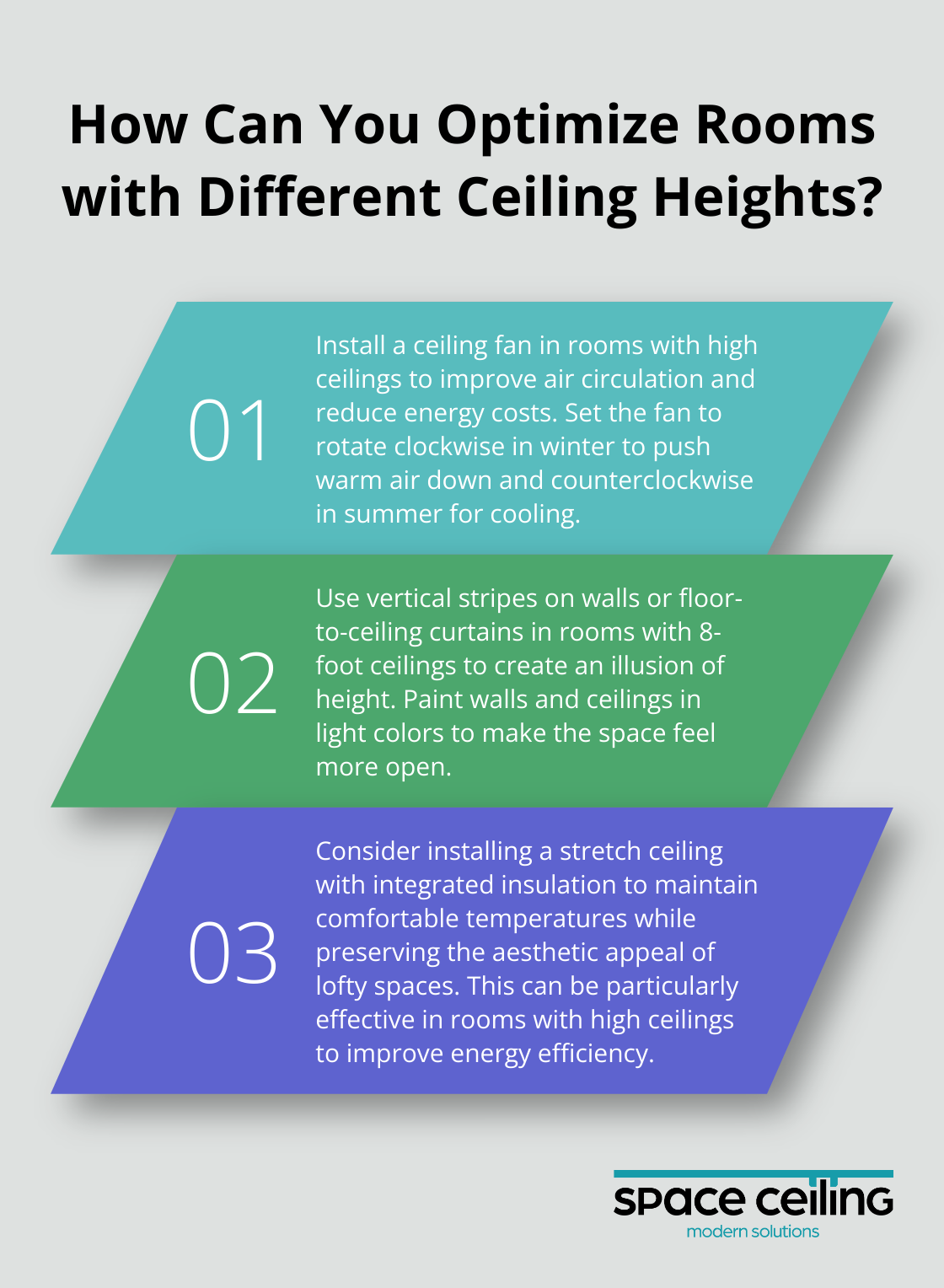
The future of residential ceiling design promises exciting developments, including more personalized and technologically integrated solutions. Smart ceilings with built-in lighting, climate control, and audio systems are gaining popularity, as are eco-friendly and health-conscious options. These innovations will continue to push the boundaries of residential design, offering both functionality and inspiration.
For those seeking innovative ceiling solutions that combine aesthetics with functionality, Space Ceiling offers a range of modern stretch ceilings to transform any space. Our versatile options provide seamless finishes, excellent acoustics, and can incorporate stunning LED lighting designs (including star and galaxy effects). We strive to help homeowners find the perfect balance between aesthetics, comfort, and efficiency that suits their unique living space and lifestyle.


